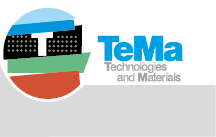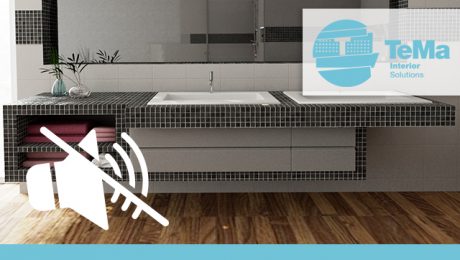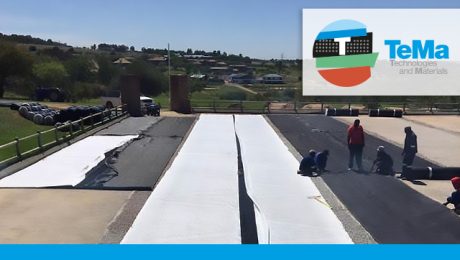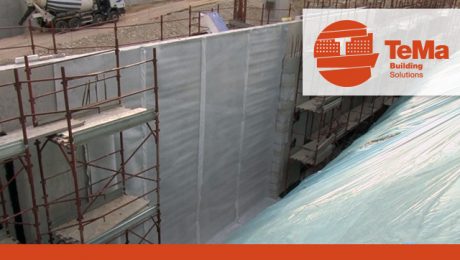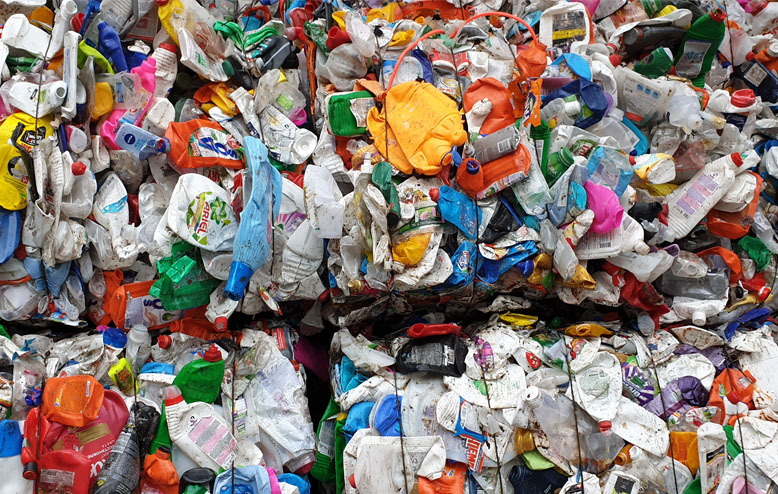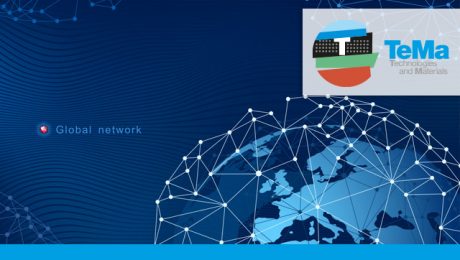Proud to be BEE certified
Our strength is that we never stop striving for the best, in everything: we are at the forefront in researching new materials, studying innovative solutions, focusing on the environment and exploiting resources… We couldn’t be any less inclusive.
Our company operates worldwide, we have branches in practically all continents and the concept of ‘internationalisation’ is our daily bread. We have always worked in contact with different people and cultures and have no difficulty in approaching them: it comes naturally to us!
We are therefore delighted to have been awarded BEE certification for our TeMa South Africa division.
What is it and how does it work?
Broad-Based Black Economic Empowerment, or B-BBEE, is a South African government initiative that encourages businesses to integrate more black citizens into all jobs, from employees to entrepreneurs, and reduce inequality in income.
The assessment is made based on 5 parameters:
- Ownership: voting rights and shareholding in the company
- Management control: members in management roles and voting rights with control over the board of directors
- Skills development: learning opportunities for developing new skills
- Enterprise development: support and development of small businesses run by black people
- Socio-economic development: corporate investment in economic and social initiatives.
Each parameter is assigned a value that creates the final percentage score, which is used to assign the category level. There are 8 of them, proceeding in descending order: 1 is the level with the highest score, 8 with the lowest score.
TeMa South Africa has been assessed by the EmpowerBEE certification agency and is a certified collaborator at Level 3 – 110% procurement recognition level.
We aim to improve further in order to reach the highest level.
Click here to find out more.
- Published in CORPORATION, news
Our approach to green energy
International Energy Saving Day is drawing near and we, being keen to respect the environment by integrating with it rather than forcing it, feel personally involved.
We are experiencing a period in which the issue of energy sources has escalated on a global scale, challenging the plans and forecasts of organisations.
Events have led to a pressing need to ensure that this particularly heartfelt situation, occurring in February 2022, is high on the agenda not only for governments but also for all businesses and families. So, we want to dedicate a few lines to it.
The ‘value’ of energy saving
Everyone knows that by ‘saving energy’ they can reduce energy consumption through all their actions and habits. By re-assessing their production and logistical processes and implementing appropriate technologies, businesses can strive to achieve minimum waste. In doing so, everyone can play their part to protect the planet, which is already somewhat damaged by the serious problems caused by climate change.
Small everyday gestures trigger cultural processes that lead to actions on a larger scale, as in the case of companies. Not out of obligation, but because it starts to be worthwhile… And it’s a real value.
How to pursue the value of sustainability
As previously mentioned, the first step must be taken by those who succeed in changing their habits and choices in order to contribute to this sustainable model, so that everyone can effectively influence decision-makers.
Nowadays, being sustainable means not wasting, not consuming energy unnecessarily by adopting methods and systems that enhance this commitment to sustainability.
Today, TeMa is acknowledged globally for having introduced, since starting out 30 years ago, geomats, geonets, geomembranes and ultra-technological products to retain and protect the soil, reinforcing it and restoring its retention power. Part of the materials used to make them comes from recycled plastic. This process takes place at two of the company’s own recovery plants in Europe. In the most vulnerable environmental situations, TeMa has now put in place biomats and bionets that help the revegetation of areas in the most natural way.
Needless to say, sustainability must be developed by using renewable energy sources that do not pollute the environment.
About 50% of the energy we use in our production processes comes from renewable sources: the IWIS Group, our partner, has three photovoltaic plants: 200 kWp, 150 kWp and 100 kWp.
It is also equipped with a co-generator that can produce an additional 800 kWp. This plant uses the heat naturally discharged by the plants to increase the efficiency of electricity production. The aim is to reduce the Carbon Footprintand CO2emissions.
TeMa Technologies and Materials was founded thirty years ago with a focus on sustainability and research. We will continue at this pace, always improving. After all, it’s our job to find solutions.
- Published in CORPORATION, Research and development, TeMa Technologies and Materials
Soundproofing the bathroom: Why not?
Having a shower in the middle of the night or at the crack of dawn, flushing the toilet, walking heavily barefoot, dropping bottles, a washing machine spinning, water draining or a jacuzzi in operation. All such activities often take place at times when your neighbours may not want to hear you.
Nothing illegal, but it’s most likely to be very annoying for any neighbours who are sleeping.
Don’t be surprised, there’s a solution to this too: install noise-reducing products in the bathroom.
Where does noise come from?
We are used to thinking that noise is transmitted through the air, but sometimes we forget that walls and pipes also transmit vibrations.
In blocks of flats this is even more amplified, as flats are generally designed in a similar way and systems run in sections between floors: this carries much more noise and rumblings.
Our solution
First and foremost, the ideal solution is to carry out a sound test in order to find out what noise is in that room and design a customised soundproofing system.
Environmental comfort can be taken care of by T-Silence dB21, the panel comprising an internal polymer core bonded with special fabrics on both sides, which reduces noise by 21 dB in a thickness of just 7.5 mm.
T-Silence dB21 is particularly suitable for renovations, as it can be dry-installed without having to a make a new screed (thus saving time, since long drying periods are not required). Furthermore, if not irreparably uneven, the old floor need not be demolished, as T-Silence can be installed over it. It can then be directly cladded with ceramic tile or wooden flooring, or a floating floor system can be installed. If, instead, you decide to remove the existing floor because it’s uneven and then lay T-Silence over the screed, as it is reduced in thickness, it isn’t necessary to intervene on the thresholds between one room and another, as no difference in level will occur.
Beware of acoustic bridges
An acoustic bridge is a critical issue that risks undermining all insulation work. It basically transmits noise and vibration. To prevent this, the joints between T-Silence dB21 panels need to be covered with dB-Strip, the paper adhesive tape impregnated with hot melt adhesive, and dB-Band, the self-adhesive band for perimeter insulation in contact with vertical walls.
Advantages
Insulating the bathroom brings the advantage of enhancing rest and therefore personal well-being.
Moreover, as it is relatively uncommon, it adds value to your property.
- Published in news
The importance of geogrids in reinforced earth structures
In recent years, reinforced earth structures have been particularly popular in projects due to their excellent functional and aesthetic importance in the residential building and public building industries.
Such intervention works achieve the best results by allowing the soil and geosynthetics to “work in synergy”, each one with its own features of ensuring the stability of the work as a whole.
It’s easy to see the high environmental value of such solutions, but let’s take a closer look at the two major factors in reinforced soil works. In this way, we can understand how and why, working together, they lead to amazing results, also in aesthetic terms.
What are reinforced earth structures?
They are structural intervention works in various gradients and dimensions aimed at retention and/or stabilisation. We can identify a few main areas of application:
- Road and railway embankments.
- Restoration and consolidation of collapsed soil on a road.
- Construction of ramps for ascending and descending flyovers.
- Canal or river bank elevations.
- Rockfall barriers.
- Noise barriers along roads or railways.
- Widening of elevated car parks.
- Construction of terracing systems in vineyards.
- Soil consolidation at tunnel entrances.

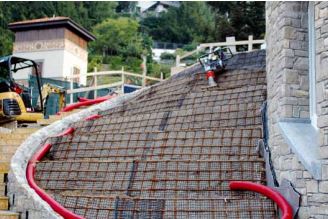
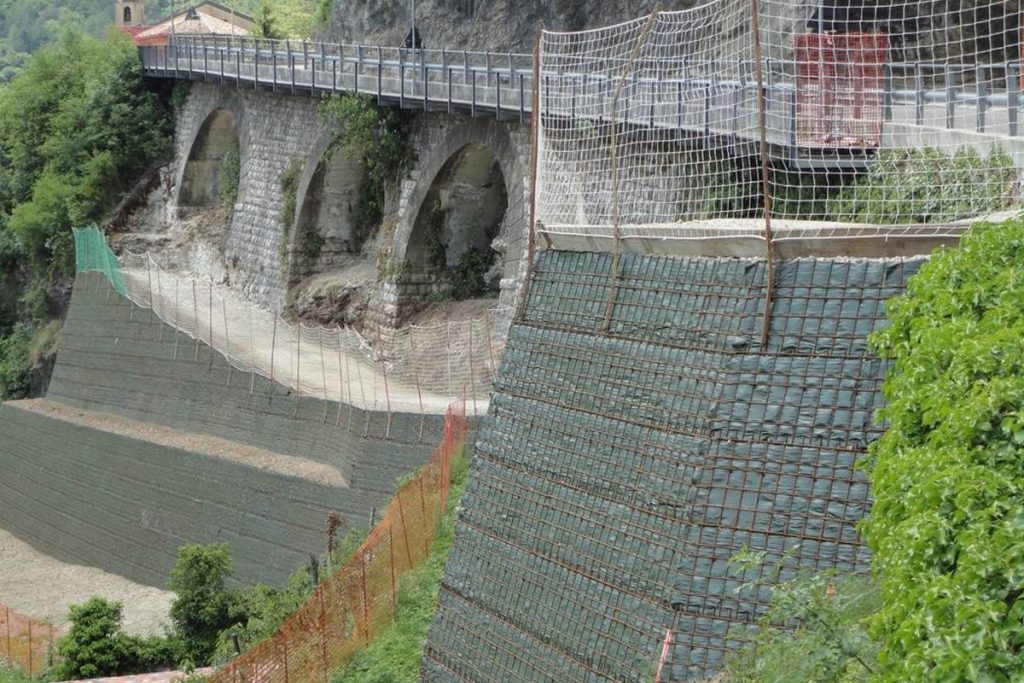
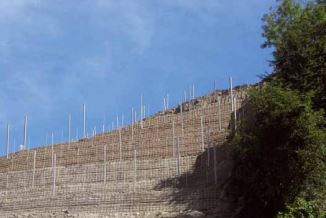
What are geogrids and why are they often the best solution?
Soil has the intrinsic features of friction and compressive strength, but practically no tensile strength. This is not enough to ensure the stability of a structure.
Major slopes, weather conditions, proximity to embankments, etc. can erode soil, causing landslides and subsidence. For reinforced earth structures, it’s therefore necessary to use geogrids, two-dimensional structures horizontally inserted into soil, which integrate with it without deforming. Their open-mesh structure develops “passive” resistance, thereby increasing the stabilising effect.
This bonding exploits the abilities of the two construction elements, making the entire structure more efficient.
Naturally, the feasibility of retaining works needs to consider:
- the intrinsic characteristics of the soil, such as grain size, the degree of thickening and shear strength, as well as the dilatancy phenomenon;
- the characteristics of the geogrids, such as tensile strength and stiffness, the use of raw materials (polymers) that can also withstand harsh chemical and physical conditions (attacks by chemical agents, soil pH, etc.), and the appropriate geometric structure.
Greening
Eventually, grass will grow and none of the intervention work will be visible: a really attractive and natural reinforced structure. In addition to its aesthetic function, greening also plays an important role in helping the natural friction of soil.
Find out more about our products here.
Experts in finding solutions: a case study
The galloping of horses, the demolishing power of hooves and a high-performance solution. In short, one of our intervention works in Kyalami, Johannesburg, South Africa (2019). This is an equestrian arena where a new moisture management and drainage system had to be designed while ensuring the durability of the work and the well-being of the horses and their hocks.
Horse racing arenas, highly exposed to weather conditions that vary with the seasons and to various training and racing activities that wear out the ground, therefore require constant maintenance. In the past, stone-aggregate layers were used for drainage, which drained rainwater (although not quickly), but had limited resistance to the continuous impact of horse hooves. In order to make the ground more resistant, it was pressed with great force, however, this had a negative effect on the safety of horses. An alternative solution was to preserve the race course as far as possible by reducing its use, i.e. not using it for training but only for competitions.
The solution based on TeMa’s decades of experience in constructing synthetic football pitches allows the construction of race courses for competitions and riding schools that use geosynthetic products. These products improve functionality, reduce intervention times and subsequent maintenance costs, also on a large scale (in our case, the surface area to be covered was 3,000 sq.m).
To find out more, click here.
Innovation in every solution
What do our clients and partners expect? For us to be there when they need us! We have therefore set up an extensive sales network in 80 countries. We rely on trained professionals who interact and meet the needs of very different markets.
We have developed three divisions in specialised areas: residential/commercial works, environmental works and indoor living comfort works. Consequently, the training and updating of our collaborators are the mainstays of our competitive advantage, as are the contributions of Universities and Research Institutes in our R&D area. Innovations arise from focusing on and listening to our clients, who primarily demand interesting and beneficial solutions.
In 2023, our company will be 30 years old, and for almost 30 years we have been harmonising our various sectors and offices to find the perfect balance. Along the way, we could not have imagined what has happened in the last 20 months. The Covid pandemic has upset the strategic balance of supply chains. So, in a world that is speeding up again, we believe that our three-division organisational set-up has helped us to truly meet the specific needs of our clients. Recruiting young people has also raised the potential for an unconventional and truly innovative outlook.
We are known as TeMa, the corporation that meets the needs of clients by operating with the precise intention of not only supplying products but also promptly finding systems and solutions that can solve any problem. This might sound like an easy advertising claim were it not for the fact that this statement encompasses other facets of the “solution maker”, which we intend to be. It is not only a matter of finding answers to problems but also solutions that are less expensive, have less impact on the environment, are quicker to apply, easier, safer and improve durability. And so on.
Such competitiveness matters to designers, builders, installers and distributors in their civil and geotechnical engineering, landscaping, erosion control, transport and soil retention projects with a low environmental impact. For them, we offer high performance to suit all situations, and we do this because we believe in protecting the environment.
- Published in CORPORATION, news, TeMa Technologies and Materials
Embankments in home gardens: small colourful islands
Made of masonry alone, embellished with different types and colours of plants and flowers, and of varying heights, embankments are often part of public buildings in parks and squares, but also a distinctive feature of private gardens. In the urban construction context, embankments can be borders for roadside verges, steps and flowerbeds, reaching a relatively low height, almost always less than 1 metre.
The provide a very attractive and organised visual effect and can be customised with the colours and types of plants you prefer. However, in order to achieve adequate stability for such intervention work, regulations require certain specifications to bear in mind for their construction.
A short and simple recap: let’s start by understanding what they are and how they are built.
What are embankments?
Embankments are accumulations of earth that form more or less evident differences in the level of the ground and can be natural or artificial. Natural embankments are caused and possibly accentuated by landslides, whereas artificial ones are man-made and consist of an earth fill supported by a wall, often in order to highlight the difference in level.
The risk of landslides
As mounds of earth, especially if they are of a certain height, embankments can be severely tested by atmospheric events, resulting in erosion and runoff due to rainwater.
Various characteristic elements can therefore be recognised:
- drainage and runoff systems in the underlying area where all rainwater accumulates;
- support and reinforcement of slopes, the part most susceptible to erosion;
- substrates and erosion control systems to allow plants to grow in the best conditions by sheltering the topsoil from the effects of the wind, sun and rain until the plants have become strong and well-rooted.
Block retaining walls and reinforcement grids
In order to prevent soil erosion or irrigation, embankments are reinforced with retaining walls in a combination of concrete blocks and geogrids, which meet geotechnical, building and architectural requirements.
TeMa Geo Solutions has the right products to create this type of construction.
For soil reinforcement we suggest X-Grid, reinforcement geogrids, which are knitted uniaxial geogrids made of high tenacity polyester yarns covered with a protective PVC layer.
For retaining walls, the range includes T-Block, a single concrete block for building reinforced walls.
The special feature of this product is the male/female joint, shaped directly on the block. This ensures maximum connection between the blocks, thus avoiding the use of mechanical fasteners, glue or mortar and making the wall stronger and more resistant to damage.

Find here all the specifications of the products mentioned.
Retaining walls: applications in residential, commercial and infrastructural contexts
Supporting walls or retaining walls are vertical structures intended to support and retain accumulations of natural or artificial materials and ensure their stability.
In the part in contact with the ground, the supporting structures are naturally covered with a waterproofing membrane, which must be protected from damage during construction operations and during subsequent settlement of the ground. The mechanical protection of the waterproofing is provided by TeMa Building Solutions T-Kone studded membranes, which also act as damp proofing, slowing down the absorption of moisture.
Moreover, when placed with the studs facing inwards, these membranes create a micro-ventilation space that is beneficial in keeping the structure dry.
In some cases, a rainwater collection system is planned around the perimeter of the building. It is necessary to use drainage geocomposites bonded with a geotextile such as T-Mix Drain, which conveys water to the drainage system envisaged in the project.
Supporting walls are used in a wide variety of areas in the building industry, from residential to infrastructural and commercial contexts.
Let’s take a look at the application in specific fields.
Residential context
It is essential to protect the underground rooms of homes, whether they are used as garages, cellars or basement rooms, in order to prevent the moisture seepage, which would damage the structure and make the indoor environment unhealthy.
TeMa Building Solutions products meet this need and are efficient in this respect.

Commercial context
TeMa Building Solutions products are also ideal for heavy loads such as underground car parks or warehouses in commercial buildings.
In such environments, TMD, the studded membrane bonded with LDPE backing foil for the mechanical protection of waterproofing membranes and the T-Mix Draindrainage geocomposite for the drainage function can also be used. In addition, the T-Comp fibreglass mat performs the subdivision function.

Infrastructures
In major infrastructural works, membranes and geocomposites must be able to withstand and resist heavy loads from the ground and hydrostatic thrust. The effectiveness of TeMa Building products is also proven for this type of construction work.
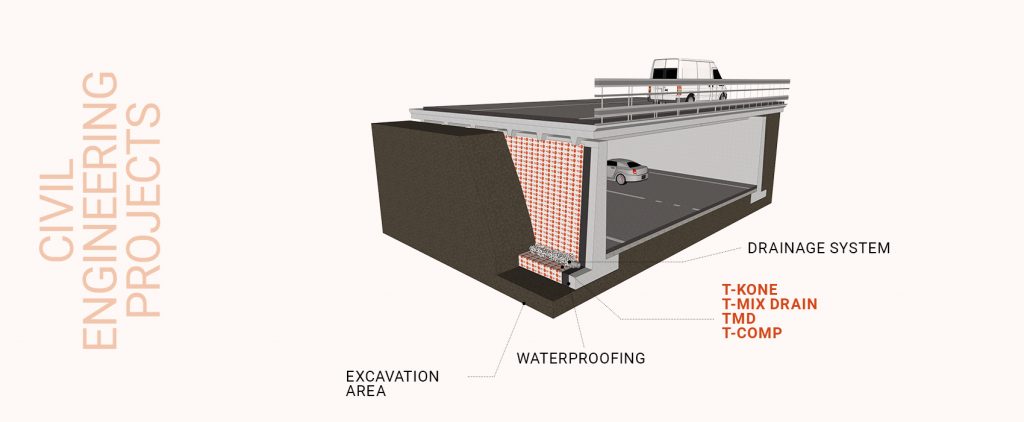
To learn more about the mentioned products, click here.
TeMa Technologies and Materials’ sustainable choice
We started out almost 30 years ago and being environmentally responsible has always been part of our philosophy, partly due to the fact that our headquarters are located less than three kilometres from the core zone of the hills recognized as a UNESCO World Heritage Site, and just over 6 km from the edge of the Cansiglio forest.
So protecting the environment was always going to be one of our key commitments, not just in our manufacturing systems, but also in the innovations implemented in the solutions we offer our customers.
Reinforced soil and CO2 savings
Our engineers have redesigned the reinforced soil system, leveraging the very pressure of the soil retained by geogrids, so as to save millions of cubic metres of concrete and aggregate, which would otherwise have to be carried to the site in hundreds of truckloads. Now it takes just one: a considerable saving in terms of CO2 in line with the goal of reducing the carbon footprint, which is the total amount of greenhouse gas emissions generated by a product or a process.
Our geonets and geogrids are made partly from recycled plastic sourced from facilities that are controlled to ensure the resulting plastic meets our standards. A substantial difference in terms of both the collection of material to be recycled and conditioned, and the recycling procedure itself (the material in question is high-density polyethylene, and polypropylene, which comes from bottles, containers, capsules and so on), as well as its preparation, for which – in order to ensure quality – we have set up two plants: EcoTeMa in Russia and Replastica in Romania.
A sustainability journey that TeMa has embarked on and is committed to pursuing further, continuing to invest in technologies and systems with a view to achieving zero emissions by 2050.
Our recycling production process
Material sorting: only materials that meet preset standards in terms of quality and type make it to the next stage. The sorted material is first shredded and then washed, then shredded and washed again. Only then does it qualify as a “raw material” ready to be turned into granules and then extruded and used in TeMa production processes.
It is supplied to our facilities across the Group for them to make into products to be introduced into the market in line with the specifications laid out by designers and in compliance with the legal requirements in the individual countries.
Where does the washing water end up?
The water used for washing is also reused once suitably treated. The portion of water not used is disposed of in compliance with specific government standards on environmental impact.
Renewable energy
Along with plastic recycling and a focus on reducing the amount of carbon dioxide released into the atmosphere, the IWIS Group has installed 3 photovoltaic systems of its own – with rated outputs of 200 kWp, 150 kWp and 100 kWp – as well as a cogenerator, together producing 50% of the energy used in manufacturing.
If you wish to receive information about it, CONTACT US.
- Published in CORPORATION, Research and development, TeMa Technologies and Materials
Internationalisation is synonymous with research and flexibility
Being an international company does not mean selling abroad. It means creating or adapting products to the needs of other countries worldwide. Products that are naturally different to ours because the morphology of the land, the climate, the critical issues at stake and therefore people’s needs, are different.
In this sense, internationalisation is the result of a corporate approach to research and the technological development of products, materials and processes. Each division of the TeMa Group, namely Interior Solutions, Building Solutions and Geo Solutions, requires technical performance, a skilled workforce and know-how that is always at the cutting edge.
TeMa Group’s labs
New products, superior performance and innovative materials are the result of close interaction between our technical/design departments and our testing and quality control labs. Not only dimensional analysis and structural checks but also durability, compression and waterproofing tests are carried out in order to test the products against set quality standards. Here are some examples. For TeMa Interior Solutions, ANSI A118.10 (American National Standard Specifications) are the standard requirements for load-bearing, bonded, waterproof membranes for laying ceramic and natural stone tiles. For TeMa Building Solutions, in addition to the CE mark, membranes bear a Declaration of Performance (DOP) that certifies how they respond to the applications for which they are intended. For TeMa Geo Solutions, the UNI EN ISO 90001:2000 certified quality system ensures that the entire production is at peak performance levels.
TeMa Group partnerships
To be forward-looking and offer innovative products, materials and processes, it is essential for us to establish collaborations and partnerships with research institutes and organisations, also on a global basis. Since 2006, TeMa Technologies and Materials has been a member of IGS, the International Geosynthetics Society, an association committed to developing geosynthetic products from a scientific and engineering perspective. Its main goal is to promote the appropriate use of these materials and their related technology worldwide.
Continuous updating therefore allows us to offer innovative solutions in line with the ever-changing needs of the market. Below you will find some interesting events planned for the year 2021-2022.
EUROGEO7, in Warsaw (Poland), from 19-22 September 2021. With the spotlight on geosynthetic products, many sessions will be offered, from using these materials in new sectors to the role they will play in the circular economy.
12 ICG 2023, in Rome, from 17-21 September 2023. The 12th International Conference on Geosynthetics. The event will focus on interaction between the academic and professional worlds and on the latest technological developments in various sectors for a more resilient planet (Geosynthetics, Leading the Way to a Resilient Planet).
- Published in CORPORATION, Exhibitions and events, news, TeMa Technologies and Materials
Environmental intervention works in keeping with our philosophy
An environmental reappraisal
Over the centuries the relationship between man and the environment has undergone considerable tensions. Rural development and the impetus in building have undoubtedly disrupted certain landscapes, reducing natural spaces to accommodate new urban and agricultural areas. This type of intervention work has led to a crisis in the ecosystem, imposing re-evaluation of the fragile balance between the economy and the environment.
This is the socio-cultural background that has led to global re-assessment aimed at defining programmes and new territorial management formulas. It has been the driving force behind TeMa Geo Solutions, the TeMa business unit dedicated to environmental intervention works. These are aimed at protecting land and offering the opportunity to operate using eco-compatible solutions and products that integrate into the environment without compromising its appearance or safety.
Sustainable development according to TeMa
Nestled at the foot of the hills declared a UNESCO World Heritage Site, the TeMa headquarters could not help but consistently correspond to this desire for sustainability, widespread in this area for some years now. But how has it contributed? By using raw materials responsibly, with 100% natural solutions and intervention procedures with low environmental impact.
Natural products
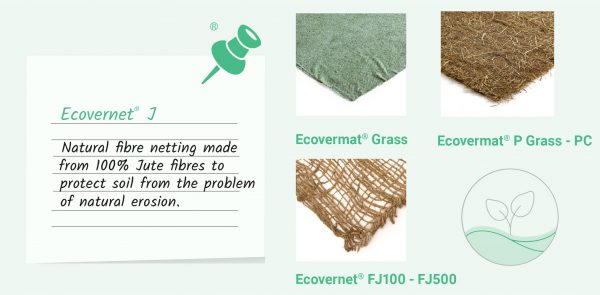
As a concrete example, TeMa addresses the problem of surface erosion of the soil by meteoric rain with Ecovernet® in natural fibres such as jute or Ecovermat® in natural fibres such as straw and coconut – or in biodegradable cellulose fibre. Installing products in this range allows intervention works to be carried out immediately, even in situations with difficult access for on-site vehicles. For such types of intervention works, total integration with the soil is achieved, guaranteeing lasting results over time.
Green intervention works

An interesting new development introduced by our technicians is the use of lightweight materials that feature reduced encumbrance, which not only affects the cost of the work but also speeds up the time required on-site. When building drainage systems, for example, TeMa does not rely on that range of inert materials from quarries that need to be extracted and transported. The company uses drainage geocomposites instead, such as Q-Drain, thus avoiding any waste of energy and CO₂ emissions into the air, thus ensuring quick installation.
These are just a few examples to show the potential that the field of environmental engineering has to offer:
- Reduction in costs while maintaining the effectiveness of intervention works
- Sustainability of the actions taken
- Protection and safeguarding of the soil
- Promotion of natural raw materials
To fully understand our philosophy, browse through the new catalogue dedicated to the protection of vineyards, which are the natural and cultural heritage of our lands and an identifying feature of our history. Inside it, you will find products and solutions for responsible and eco-compatible actions.
- Published in Drainage geocomposites and membranes, Erosion mats, GEO, Research and development
